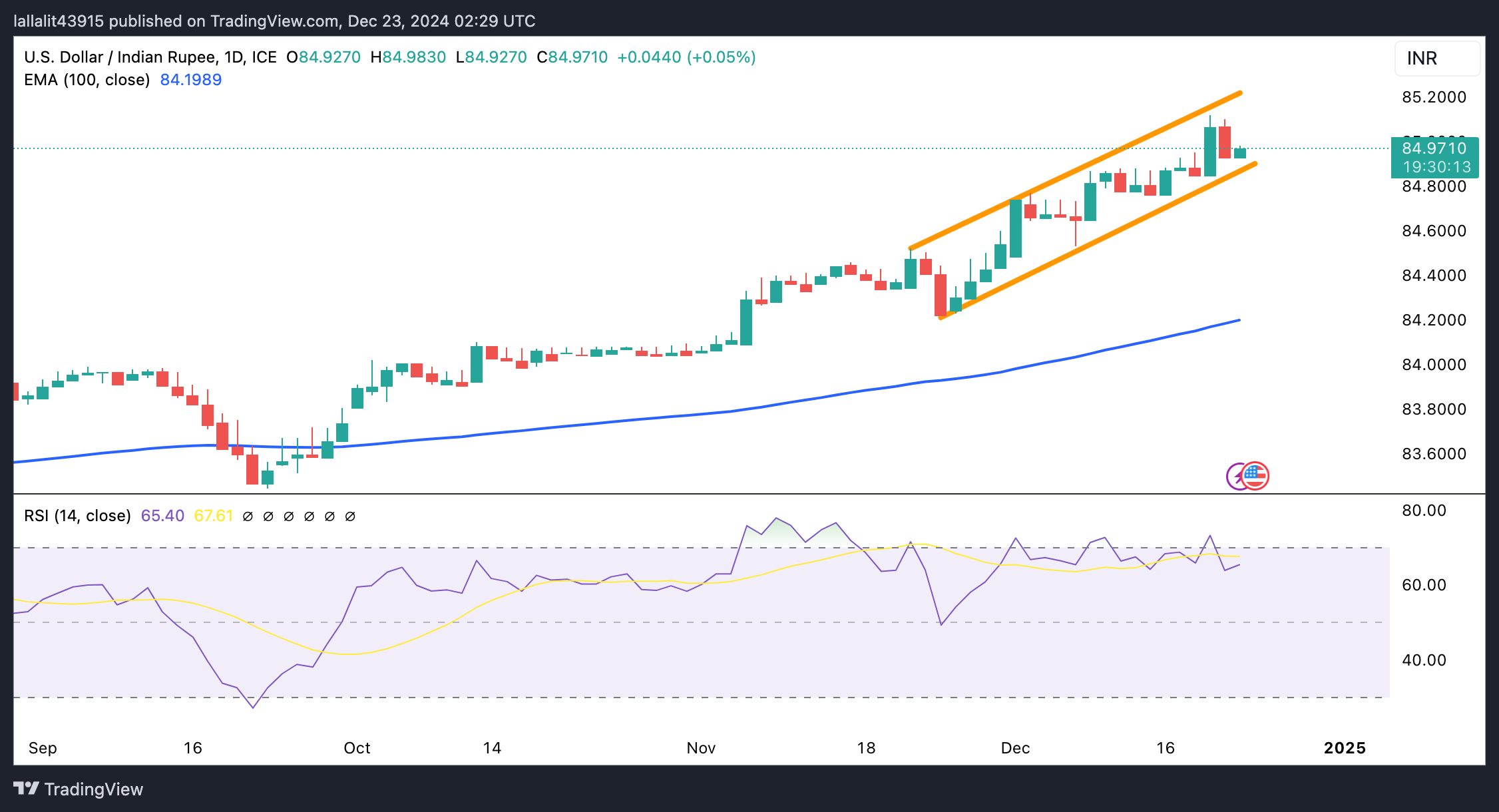USD/INR drifts higher amid bullish US Dollar demand
- The Indian Rupee weakens in Monday’s early Asian session.
- A broadly stronger US Dollar weighs on the INR, but routine interventions by the RBI might cap the pair’s downside.
- Investors await the US December Consumer Confidence, which is due later on Monday.
The Indian Rupee (INR) remains weak on Monday after reaching an all-time low in the previous session. The persistent strength of the US Dollar, driven by the Federal Reserve's (Fed) hawkish tilt undermines emerging market currencies like the local currency.
On the other hand, the Reserve Bank of India (RBI) could step into the foreign exchange market by selling the USD. This might help limit the INR’s losses for the time being. Looking ahead, the US December Consumer Confidence and Chicago Fed National Activity Index are due later on Monday. On Tuesday, Durable Goods Orders will be released.
Indian Rupee seems vulnerable amid hawkish Fed expectations
- India's foreign exchange reserves fell in nine out of the past 10 weeks, hitting a multi-month low. The reserves had been falling ever since reserves touched an all-time high of USD 704.89 billion in September, and now last week the forex stood at USD 654.857 billion, according to the RBI data.
- "Higher trade deficit along with slow growth figures puts rupee on test with outflows from domestic equity markets. For USD/INR, positionally 84.70 now acts as a good base while the door remains open for 85.50 levels," said Kunal Sodhani, vice president at Shinhan Bank India.
- The Commerce Department reported on Friday that the US Personal Consumption Expenditures (PCE) Price Index advanced 2.4% YoY in November after rising 2.3% in October. The reading came in softer than the expectations of 2.5%.
- The US Core PCE, excluding the volatile food and energy components, climbed 2.8% YoY in November after advancing by the same margin in October, but below the 2.9% expected.
USD/INR retains longer-term bullish bias
The Indian Rupee trades on a weaker note on the day. The strong uptrend of the USD/INR pair remains intact as the pair holds above the key 100-day Exponential Moving Average (EMA) on the daily timeframe. The path of least resistance is to the upside as the pair, with the 14-day Relative Strength Index (RSI) standing above the midline near 65.40.
Bullish candlesticks that could take USD/INR could take to the ascending channel at 85.20. Extended gains could see a rally to 85.50.
On the flip side, the lower boundary of the channel at 84.88 acts as an initial support level for the pair. A breach of this level could pave the way to 84.19, the 100-day EMA.

Indian Rupee FAQs
The Indian Rupee (INR) is one of the most sensitive currencies to external factors. The price of Crude Oil (the country is highly dependent on imported Oil), the value of the US Dollar – most trade is conducted in USD – and the level of foreign investment, are all influential. Direct intervention by the Reserve Bank of India (RBI) in FX markets to keep the exchange rate stable, as well as the level of interest rates set by the RBI, are further major influencing factors on the Rupee.
The Reserve Bank of India (RBI) actively intervenes in forex markets to maintain a stable exchange rate, to help facilitate trade. In addition, the RBI tries to maintain the inflation rate at its 4% target by adjusting interest rates. Higher interest rates usually strengthen the Rupee. This is due to the role of the ‘carry trade’ in which investors borrow in countries with lower interest rates so as to place their money in countries’ offering relatively higher interest rates and profit from the difference.
Macroeconomic factors that influence the value of the Rupee include inflation, interest rates, the economic growth rate (GDP), the balance of trade, and inflows from foreign investment. A higher growth rate can lead to more overseas investment, pushing up demand for the Rupee. A less negative balance of trade will eventually lead to a stronger Rupee. Higher interest rates, especially real rates (interest rates less inflation) are also positive for the Rupee. A risk-on environment can lead to greater inflows of Foreign Direct and Indirect Investment (FDI and FII), which also benefit the Rupee.
Higher inflation, particularly, if it is comparatively higher than India’s peers, is generally negative for the currency as it reflects devaluation through oversupply. Inflation also increases the cost of exports, leading to more Rupees being sold to purchase foreign imports, which is Rupee-negative. At the same time, higher inflation usually leads to the Reserve Bank of India (RBI) raising interest rates and this can be positive for the Rupee, due to increased demand from international investors. The opposite effect is true of lower inflation.



